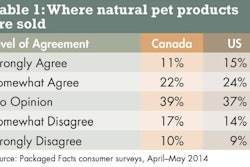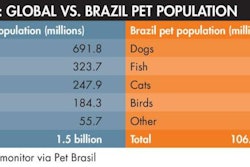Raw/frozen/refrigerated/freeze-dried petfood is often all lumped together under the catch-all, vague category of “alternative” petfood. The term is quickly becoming a misnomer: While still small, these market segments are growing rapidly in sales, number of products offered (and sought by pet owners) and number of companies entering the market—meaning the segments are approaching mainstream status.
So, it must be increasingly frustrating for proponents of these pet diets as well as manufacturers of these petfoods to see the seemingly never-ending advisories and warnings from government agencies, veterinary schools and associations, and related organizations about the supposed dangers of feeding raw diets to pets.
For example, the US Food and Drug Administration (FDA) issued an advisory in July, following on the heels of ones earlier in the year from the Colorado State University Veterinary Teaching Hospital and previous statements from the American Veterinary Medical Association and American Animal Hospital Association. “Raw petfood consists primarily of meat, bones and organs that haven’t been cooked, and therefore are more likely than cooked food to contain organisms that can make a dog or cat sick,” said the FDA statement, attributing this definition to William J. Burkholder, DVM, PhD, veterinary medical officer in the Division of Animal Feeds.
That statement gets right at the heart of the problem with these advisories and warnings: They tend to lump all raw petfood under one very vague, uninformed definition. (Hmmm, are we seeing a pattern here?)
This definition seems to target home-prepared raw pet diets, and probably rightly so; studies have shown that most home-prepared diets, raw or cooked, tend to be deficient in necessary nutrients for dogs and cats. That’s in addition to the viable contamination concern pointed out by FDA, Colorado State and other entities.
But what about commercially prepared and marketed raw petfoods? The fast-growing sales of these raw/frozen/refrigerated/freeze-dried products are testament to not only rising consumer demand but also the development of more products in these segments and the increasing number of companies offering such diets. And this growth—in sales, products and companies—is global. For example, new petfood products on display at Interzoo 2014 in Germany strongly indicated a resurgence in BARF (biologically appropriate raw foods), particularly among German petfood companies.
A potent new product development pipeline and strong sales are not the only positive aspects of this petfood market segment; these companies are also often leading the way in terms of product safety, using cutting-edge technologies such as high pressure processing and often employing thorough testing of finished products before distribution. Yes, raw petfood companies have issued recalls in the past few years, but at no higher numbers or frequency than companies marketing petfoods in more traditional categories. (Some might argue that raw petfood has a much lower instance of recalls proportionate to the segment’s size.)
A recent study by the Veterinary Laboratory Investigation and Response Network and FDA's Food Emergency Response Network found higher levels of pathogens in frozen raw petfood chubs than in dry and semi-moist foods, but the traditional formats were not dog and cat foods—rather, they were products for other species. That's not exactly a valid comparison.
Perhaps part of the reason why warnings about raw petfood are not more discriminate or targeted is because this market category is so amorphous and ill-defined itself—that lumping of all similar products into one category of “alternative” petfood. As sales growth likely continues, let’s hope petfood companies making or marketing these products make a concerted effort to better define their dynamic segment.
















